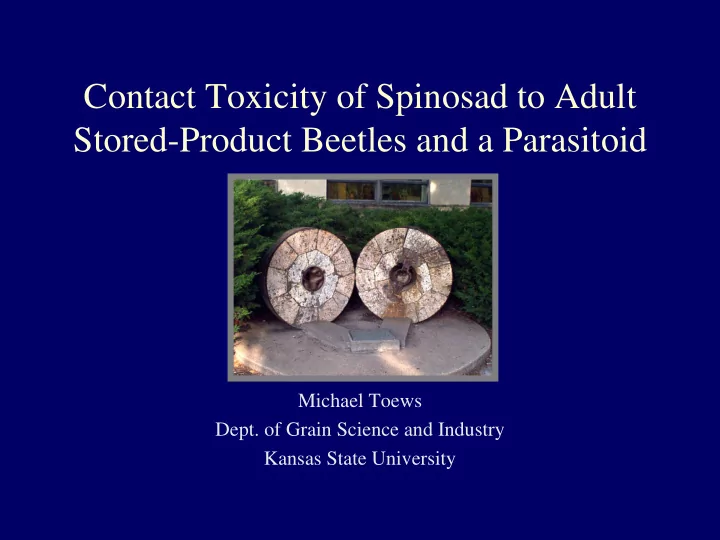

Contact Toxicity of Spinosad to Adult Stored-Product Beetles and a Parasitoid Michael Toews Dept. of Grain Science and Industry Kansas State University
Spinosad • Metabolite of the actinomycete bacterium Saccharopolyspora spinosa • MOA is reported to be through the nicotinic and GABA-gated ion channels (however, they are unique binding sites) • Is marketed for insect control in production agriculture, horticulture, gardens and around homes • Has shown no cross resistance Source: Spinosad Technical Bulletin
Spinosad • Essentially non-hazardous to terrestrial birds, mammals, and some aquatic species • Acute oral LD 50 levels – Rat >3738 mg/kg – Bobwhite Quail >2000 mg/kg – Rainbow Trout 30 mg/l – Earthworm >970 mg/kg • Reported to have minimum disruption of beneficial insects and non-target organisms
Spinosad • DAS has applied for an • Proposed EUP covers the experimental use permit following states: (EUP) for testing on stored grain – Arkansas, Georgia, – Barley Indiana, Kansas, – Corn Minnesota, Montana, – Oats and Oklahoma – Rice – Sorghum – Wheat
Use in Stored Wheat • Previous papers* showed excellent control of LGB (1 mg/kg) and RW (3+ mg/kg) • RFB and STGB not very susceptible • Our hypothesis is that the method of exposure and feeding habits contribute to differences in susceptibility • Biological control/aeration could potentially be used in concert with Spinosad _________________________________ *Subramanyam, Bh., J. Nelson, L. Fang. In press. Evaluation of spinosad on stored product insects. J. Stored Prod. Res. Fang, L., Bh. Subramanyam, and F. Arthur. (in review) Effectiveness of spinosad on four classes of wheat against five stored product insects. J. Econ. Entomol.
Test Insects
Contact Toxicity of Spinosad • Suspended insecticide in acetone • Applied acetone to inside surfaces of Petri dishes • Allowed 1 hour for acetone to dissipate • Placed 40 adult insects (<7- d old) in each dish • Held at 30°C, 50% RH • 3-6 replications per treatment level
Dose-Response Assays, 24 h 1.00 Proportion killed 0.75 0.50 0.25 0.00 0.01 0.1 1 10 Control 0.01 Spinosad concentration (log 10 scale) < 5% mortality in control < 5% mortality in control
Dose-Response Assays, 24 h 200 1.00 150 Proportion killed No. eggs/dish 0.75 100 0.50 0.25 50 0.00 0 0.01 0.1 1 10 0.01 0.1 1 10 Spinosad concentration (log 10 scale) < 5% mortality in control < 5% mortality in control
24 Hour Bioassays 1.00 Proportion killed 0.75 0.50 0.25 0.00 0.1 1 10 0.1 1 10 100 Spinosad concentration (log 10 scale) < 5% mortality in control < 5% mortality in control
48 Hour Comparison Rate = 0.1 mg/dish Rate = 1.0 mg/dish = 0.0016 mg/cm 2 = 0.0160 mg/cm 2 1.00 *** *** Proportion killed 0.75 0.50 0.25 0.00 RFB RW LGB RFB RW LGB Insect Species *** = significant at α α = 0.05 < 5% mortality in control = 0.05 < 5% mortality in control *** = significant at
Conclusions • Spinosad has contact activity to adult insects and T. elegans • Ingestion is not required • LGB is the most susceptible followed by RW and RFB • T. elegans was highly susceptible
Additional Spinosad Research • Determining • Comparison of LD 50 susceptibility to and LD 90 values different parasitoids among species • Effects of grain • Spinosad plus aeration condition on insect as a strategy for farm- susceptibility stored wheat
Other RAMP Projects • Sampling static and moving mill stock in flour mills for insect infestation • Correlate insect counts with trap counts • Develop a viable sampling plan for use in this environment Data: Newell Good (1937; J Kansas Entomol. Soc.)
Recommend
More recommend